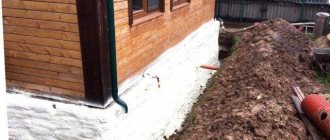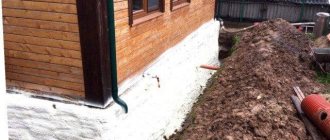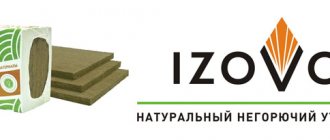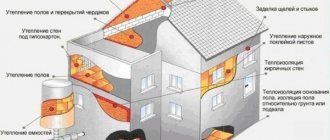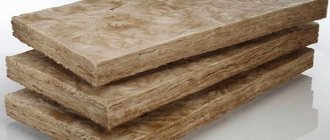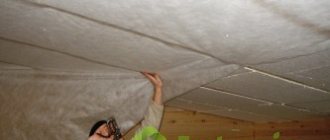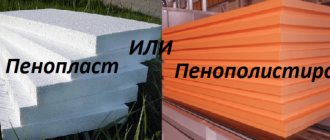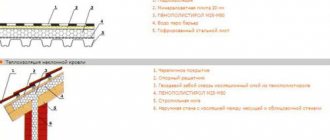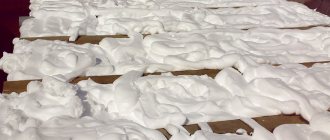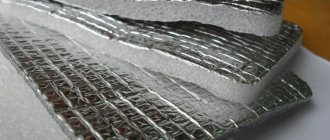Advantages of sprayed insulation
This insulation material has a number of priority advantages, successfully competing with any roll and slab thermal insulators. A feature of sprayed insulation is the simplicity of the insulation process. For this purpose, a high-pressure cylinder unit is used, through which two structural components are sprayed and, when combined, form polyurethane foam.
Many people have probably seen a similar material like this when using polyurethane foam to insulate window openings. Sprayed wall insulation looks similar.
Sprayed insulation is quite light in weight and can be applied to a surface of any material in a layer of any thickness without consequences. At the same time, sprayed insulation materials are also known for their technological parameters that ensure practicality of use:
- The highest thermal conductivity indicator is observed for these materials, and is about 0.020-0.028 W/mS. In more modern insulation materials this figure is even lower - 0.017 W/mS
- Excellent sound insulation performance. This category of insulators successfully neutralizes even impact noise, ensuring silence in the room when working with construction tools
- The vapor permeability of sprayed heat insulators allows them to absorb moisture without creating comfortable conditions for the formation of condensation
- The use of this material allows you to insulate even hard-to-reach places due to its consistency
- The adhesion parameters inherent in this thermal insulation material make it possible to insulate surfaces made of any materials
Warning. Even with all the positive reviews about the adhesion of sprayed materials, their preliminary preparation should not be neglected. Smooth, oily, and surfaces made of polyethylene and other materials may poorly adhere to the insulation without degreasing, especially if the structure of the heat insulator is open-cell.
- The turnaround time for work with this insulation can also be called a record - to insulate 100-120 square meters, 8-9 hours are enough, with a low labor intensity of the process
- This is one of the few insulation materials that does not require hydro- and vapor barrier installation.
- The characteristics of spray-type insulation also include resistance to manifestations of biological and chemical origin.
Are you wondering what type of insulation is not chewed by mice? Another advantage of sprayed insulation is that it does not arouse interest among rodents, which have become a real problem when insulating with some other categories of insulation.
Rating of sprayed polyurethane insulation from 200 rubles
Teplis (302065), 1000 ml
The purpose of the product is insulation of verandas, attics, loggias, facades, basements, attics, utilities, pipelines. It is used as a heat-insulating material for the treatment of vans - thermoses, warehouse and garage doors, industrial premises. Special polymer materials are used in production. Features ideal adhesion. There is no need to pre-level the surface, seal it, or install the frame. No additional tools or materials are needed for the job. Thermal conductivity is low. Moisture resistance is excellent. Even an amateur in construction can do the job.
Consistency – stable foam. The main component is polyurethane. The color of the composition is bluish. The structure is uniform, medium-fine. One can is enough to apply a layer of 2 mm over an area of 3 sq.m. Complete polymerization occurs in 60 minutes. An additional layer can be applied 20 minutes after the first ball. Retains its original properties for half a century. It adheres well to cast iron and aluminum, as well as to wood, concrete, brick and plywood.
The average price is 365 rubles.
sprayed polyurethane insulation Teplis (302065), 1000 ml
Advantages:
- inexpensive;
- seamless insulation;
- cold bridges do not appear;
- excellent option for hard-to-reach areas;
- fills cracks and joints;
- functionality;
- ease of application;
- long service life;
- practicality.
Flaws:
- not identified.
Vasmann Thermofoam

Budget products from a domestic manufacturer. The volume of the can is 890 ml. Can be used at temperatures from +5 to +35 degrees. Will cover 2.5 m of surface. Purchased for insulation of industrial and residential buildings, foundations and roofs, as well as walls. The products can be used to insulate heating, water supply and drainage systems, as well as pipelines. Suitable for isothermal vans and passenger cars. It will qualitatively cover hard-to-reach areas and crevices.
Sold in aerosol packaging. The composition is one-component, polyurethane. Completely ready to use. Suitable for internal and external insulation. It is applied by spraying using a gun with a spray nozzle. Hardening occurs when exposed to moisture. There are no ozone-depleting substances in the composition. Can be purchased both wholesale and retail. The optimal application thickness is 2 cm.
You can purchase the products at a price of 383 rubles.
sprayed polyurethane insulation Vasmann Thermofoam
Advantages:
- excellent thermal insulation and adhesive properties;
- value for money;
- can be applied both horizontally and vertically;
- optimal spending;
- functionality.
Flaws:
- preliminary cleaning of the surface from dirt, dust, and grease stains is required.
Goldifoam (GFFI)

Product from a domestic manufacturer. It is released from a cylinder using a professional pistol. Belongs to the single-component category. It is made in the form of a spray. The base is polyurethane. The main purpose is the insulation of economic, domestic and other building structures. Apply to any surface, including vertical and inclined (roof slopes). Purchased for work in small areas. It can be used as additional insulation on irregularly geometric and too uneven surfaces, as well as in cases where it is not possible to lay sheet thermal insulation.
Suitable for exterior and interior use. Apply a layer of 2.5 cm. You can lay several balls. It has a fine-cell structure. Used at temperatures from -10 to +35 degrees, while the temperature of the cylinder should not be less than 15 - 35 degrees Celsius. For half a century it retains its original qualities, regardless of temperature conditions. Withstands heat up to 90 degrees and frosts up to 40 degrees. Complete curing of the layer occurs in 12 hours. At the end of polymerization, no toxic compounds are released; it is chemically neutral.
The purchase price is 285 rubles.
sprayed polyurethane insulation Goldifoam (GFFI)
Advantages:
- excellent thermal barrier;
- resistance to mold and fungi;
- ideal adhesion to various surfaces, including fluoroplastic;
- absence of ozonizing compounds and solvents;
- versatility;
- practicality;
- can be used as an auxiliary product;
- ideal material for geometrically irregular surfaces;
- can be used in combination with polyurethane foam to insulate joints and cracks;
- long service life;
- ease of use;
- safety;
- acceptable price.
Flaws:
- not installed.
Where to use spray insulation
Due to compliance with safety standards, sprayed insulation can be used in public and residential buildings. The range of its application is quite universal:
- Roofing and attic structures
- Insulation of floors
- Insulation of wall surfaces
Objects can be classified as follows:
- Industrial buildings
- Outbuildings
- Refrigeration equipment
- Pipeline communications
- Vessels for technological purposes
Important to consider! Although spray-on insulation is considered environmentally friendly, thoughtful precautions must be taken when installing insulation in residential buildings. At the moment of application of the material, a polymerization reaction occurs, accompanied by a high degree of toxicity. And only after final hardening the risk of poisoning disappears completely.
As for the type of materials that can be used for insulation, there are no restrictions in this regard.
DIY spray insulation
Many owners of private houses, and even apartments, try to do all the work around the house with their own hands. But in this case, doing this without theoretical training and the necessary equipment is not easy.
In any case, for self-insulation with polyurethane foam you will need a balloon installation and the components necessary for this procedure, namely:
- Polyol, which must be mixed in a container with freon
- Isocyanate, also combined with Freon 134
Both cylinders must be inflated until the pressure in them reaches at least 8 atmospheres.
Next, spraying is carried out on the treated and prepared surface - just press the spray gun and direct a stream of insulation to the desired area.
Attention! When working independently with sprayed insulation, it is imperative to use personal protective equipment!
Sprayed insulation in cylinders
Since the independent process is not as complicated as its preparation, it will be easier to immediately resort to ready-made insulation kits in cylinders. In addition, there will be no noticeable difference in cost.
Sprayed insulation in cylinders is more practical, as it has been professionally prepared at the factory, including optimal pressure conditions.
Price for sprayed insulation
The cost of this insulation may seem slightly higher than materials in other categories. However, the economic efficiency of this thermal insulator is obvious when calculating, of course, the cost of other materials with the inclusion of additional equipment - profiles, sealants, fasteners and payment for the cost of professional work.
In the long term, the cost of insulation with sprayed insulation pays off by reducing energy costs.
Sprayed polyurethane insulation Polynor
An example of a successful choice of such insulation is Polynor insulation. Its advantages are evidenced by reviews of Polynor sprayed polyurethane insulation and instructions provided by the manufacturer in video format. The price for sprayed polyurethane insulation Polynor is identical to similar sprayed insulation in this category.
Thus, this type of thermal insulators is a priority in the choice of material for a number of technological indicators and for reasons of practical and budgetary value.
Features of insulation application technology
The technology for installing sprayed insulation in cylinders involves the following steps:
- the cylinder is equipped with a special tube or gun, having first removed the lid;
- shake the composition thoroughly for at least 60 seconds;
- before applying foam thermal insulation, the surface is treated with water;
- The cylinder is held with the bottom up, the voids are filled to 1/3 of the volume, leaving room for expansion of the composition.
When the foam fills the entire volume of the gap, it is recommended to sprinkle the mass with water to improve the polymerization process. Curing time for foam insulation varies depending on the model and brand, and manufacturers produce products of varying quality. Surface hardening is observed within approximately 20 minutes after spraying. Correction of the mass using a cutting tool begins no earlier than after 4 hours. The full period of polymerization of foam floor insulation in cylinders requires a period of at least 24 hours.
Providing protective equipment
When applying polyurethane foam in cylinders for floor insulation, it is worth considering that the composition is poorly washed off from skin and clothing
You should work in protective clothing; it is also important to use safety glasses and gloves. Manipulations of spraying polyurethane foam with special equipment are performed using professional equipment to completely eliminate contact of the skin and mucous membranes with the substance
When insulating a floor with foam, you need to use protective equipment
Thermal insulation of the floor by spraying
Installation of polyurethane foam when insulating floors using spraying technology involves the use of special installations. The foam insulator components are contained in separate tanks. The working composition is prepared directly on site before use. Substances enter the mixing device, are then sent to a spray gun and applied under pressure to the surface to be treated.
Features of installation of foam insulation:
- a frame structure is constructed for applying spray-on thermal insulation. Experts recommend lathing depending on the nature of the area being treated. For example, for effective thermal insulation of a wall structure, it is advisable to build a wooden or metal frame with an interval between guides of 30 cm. If you plan to insulate the floor with sprayed polyurethane foam, you should create a sheathing in increments of up to 1 m;
- the foam composition is applied by smoothly moving the jet over the surface to ensure uniform distribution of the mass;
- when processing vertical planes, foam insulator is sprayed from the lower perimeter, gradually filling the openings upward;
- When manipulating, keep the spray gun at a distance of at least 25 cm from the surface to be treated. When moving to another sector, you must release the gun trigger to block the stream.
If you plan to insulate the floor with two-layer spray foam, it is necessary to allow time for complete polymerization of the previous layer. After the mass has hardened, adjustments begin: cut off all protruding fragments with a sharp knife and level out any unevenness.
The flooring is laid after the foam insulation has completely polymerized.
Floor insulation by pouring method
The technology involves creating monolithic thermal insulation in the floor structure by pouring foam into specially made cavities. For example, a rough plank floor is constructed on joists, and small holes are made on the surface in designated areas for pumping polyurethane foam. If thermal protection of walls is planned by pouring polyurethane foam, the cladding is performed with a technical gap between the base and the finishing material. Next, the foam composition is poured through special holes on the facing panel.
Filling is carried out on the basis of the same spraying installations, reconfiguring the equipment parameters. In a professional environment, special units are also used for pouring polyurethane foam, which determines the high-quality level of thermal insulation work. The foam substance exclusively fills all voids down to the slightest cracks, resulting in the formation of a sealed thermal barrier with high performance characteristics.
Basic information
Polyurethane foam is a type of gas-filled plastic (foam). The structure of this material consists of cells that are filled with heat-insulating material (carbon dioxide or freon).
Nowadays, various types of polyurethane foam are in great demand because they are very easy to produce directly on the construction site by mixing two liquid ingredients that react chemically with each other. If the required proportions are observed, a polymer is synthesized, which is a hardened foam. By changing the manufacturing recipe, it is possible to obtain polyurethane foams with different properties. Currently, there are three types of polyurethane foam: hard; medium hardness; soft. One of them is suitable for thermal insulation of doors and windows, the other for insulating houses made of reinforced concrete or brick, and the third for a variety of pipelines.
Features of application
Thermal insulation by spraying polyurethane foam needs protection from the sun's harmful rays. That is, a light-proof finish must be applied on top of the applied layer. It is also undesirable to use flammable polyurethane foam for insulating wooden buildings. Despite the presence of fire retardant compounds in the mixture, the manufacturers failed to achieve absolute fire safety.
Another disadvantage of polyurethane foam is the toxic substances released from the foam during the polymerization process. So during work you need to use a good respirator and generally take care of your own safety. Well, the cost of insulation with polyurethane foam is very high, per 1 sq. m it ranges from 550-680 rubles with a layer of 5 cm. But polyurethane foam has a low thermal conductivity of about 0.019-0.028 W/m∙K and, if properly sprayed, can last at least 20-30 years. You can read more about working with such material in this article about polyurethane foam.
Main application steps
If you carry out insulation yourself by spraying polyurethane foam, you will need special equipment with a compressor and a pneumatic gun for the work. Ideally, this should be an automated foam generator that controls all mixing and supply parameters.
After this, you will need to order from the manufacturer a two-component composition for preparing PPU thermal insulation. In further work, follow the instructions:
1. Mix the first ingredient with a construction mixer to evenly distribute foaming agents, regulators, fire retardants and polyesters.
2. In a separate container, prepare a hardener - the second component of thermal insulation. If a precipitate appears in it, heat it to +70 °C, stir again and filter.
3. The combination of two ingredients must be carried out in a completely dry room, where foreign objects or substances cannot enter the mixture.
4. The finished thermal insulation is fed by a compressor into a special sleeve and applied from a gun to the surface to be treated under pressure.
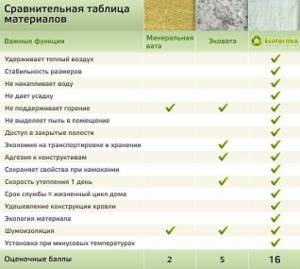
Typically, the proportions of two-component mixtures are kept at 1:1, but the dosage should be checked with the manufacturer. The process of spraying insulation itself, judging by reviews, does not require any skills or complex training. Before insulation, you just need to clean the base from dust and loose pieces, and dry it thoroughly. Immediately after this, polyurethane foam is applied in a layer of 10-15 mm. A second pass is performed on an already frozen base.
Ecowool
This insulation is completely different from polyurethane foam, since it consists of natural components (cellulose), and is 40 percent cheaper. True, its thermal conductivity is higher - 0.032-0.041 W/m∙K. In our review, we will look at ecowool, which involves spraying using a wet-glue method. This is the most expensive, but also the most effective method of its use. The lucky ones living in areas where there are their own manufacturers of thermal insulation made from paper raw materials can count on the minimum price. To apply dry ecowool and the adhesive component, it is enough to dilute it with water in the correct proportion and use a pneumatic gun to spray it in a continuous layer over the surface. According to reviews, you can do without glue, but it is more reliable.
The density of ecowool is approximately 52-65 kg/m3, which guarantees its normal operation as insulation. But unlike polyurethane foam, it does not have proper moisture resistance, so it requires additional protection. However, with slight moisture (up to 14%), ecowool does not lose its properties - it “acts” like wood, releasing excess moisture rather than accumulating it. A really serious drawback is the flowability and shrinkage of the insulation - every year, cellulose insulation loses up to 1.2% of its original volume. Over 5-10 years of service, ecowool will sag by 6-12%, so manufacturers and craftsmen in their reviews recommend making a thicker layer.

When to use spray-on insulation:
1. Since spraying allows you to create a continuous layer, it is ideal for processing non-standard surfaces with protrusions, non-rectangular cells and irregularities.
2. This type of coating is indispensable for thermal insulation of any building structures with a large number of metal elements. Spraying polyurethane foam provides them with reliable protection from moisture penetration and subsequent corrosion.
3. For insulation of pipes and containers for various purposes.
Main directions of use of polyurethane foam
The scope of application of polyurethane foam as a heat insulator is very extensive. It is used in the manufacture of refrigerators, upholstered furniture, car seats, and bed mattresses. Polyurethane foam is used to produce cotton wool substitutes, orthopedic shoes, sanitary napkins and tampons, prostheses, and surgical tappers. Raincoats, coats, and jackets are insulated with elastic polyurethane foam films.
In addition to household goods, polyurethane foam is used in the production of hulls of light ships, for thermal insulation of fuel tanks of engines of the second stage of space rockets.
Types of sprayed polyurethane foam
Polyurethane foam insulation, which is applied by spraying, is divided into two categories: industrial - sold in barrels and used by specialists to insulate large structures and surfaces, and in 1-liter cylinders, which are intended for independent use. Industrial polyurethane foam is represented by several brands from different manufacturers.
The most famous are:
- Sealection 500 is an American made material. It has an open structure and fire safety class G2.
- “Ecotermix” is produced on the basis of vegetable oils and contains a minimum amount of harmful substances. There are two varieties of it on sale: grade 300 - with a closed structure to protect external surfaces from cold, and grade 600 - with an open structure for interior work.
- Healtok Soy 200 is a closed-structure insulation material made from soybean oil and polymer waste. Adheses perfectly to any surface, tightly fills all cracks and pores.
Polyurethane foam in cylinders is made from polymer components. The can has a spray tip or adapter for use with a mounting gun. Currently, this insulation is represented on the market by two brands - Polinor and TEPLIS. The material looks like polyurethane foam. After hardening, it forms a fine-mesh coating with low thermal conductivity. One cylinder is enough for 1 sq. m of surface when applied in a layer of 40 mm.
The application technology is simple:
- Surfaces must be cleaned of dust and dirt and slightly moistened.
- You need to screw the nozzle onto the cylinder.
- Then it is shaken and the nozzle is directed to the desired location.
- By pressing the trigger of the gun, the material is sprayed.
Currently, insulation in cylinders is heavily advertised, but experts do not advise trusting advertising too much.
Manufacturers of industrial two-component insulation believe that one-component polyurethane foam in cylinders is practically no different from conventional polyurethane foam, but costs several times more. The material has a large number of open pores, therefore it is unsuitable as a hydro- and vapor barrier.
Therefore, if you decide to properly insulate your home, you should not rely on unprofessional insulation. If you wish, you can use a spray can to treat small areas of structures or internal partitions, but it is hardly suitable for insulating large surfaces.
Polyurethane foam spraying
This type of insulation is obtained by mixing two liquid ingredients - isocyanate and polyol. A fluffy mass of air-filled microcapsules can be obtained by mixing these liquids in any container. There are two technologies for using polyurethane foam as insulation for floors, roofs, and walls of buildings from the inside and outside - spraying and pouring.
When spraying, as a result of mixing the isocyanate and polyol with air, a fine aerosol is formed, which is applied to the outside surface using a spray gun like regular paint. Mixing isocyanate and polyol without access to air makes it possible to obtain a homogeneous liquid, which can be filled into a limited cavity of any shape. Only 3% of the total volume of the final product is polyurethane foam, the remaining 97% is gas.
Features of the material
Sprayed polyurethane thermal insulation refers to a substance formed by mixing two components ( polyol and isocyanate ). Filling or spraying can be used to lay the finished material . The first method is well suited for insulating large areas and filling voids inside engineering structures. The spraying method allows you to create a higher quality surface. In this case, the components are mixed under pressure inside special generators, and then supplied to the outside using a spray gun.
For use in everyday life and in local areas (inside cracks, gaps, openings), one-component polyurethane foam compositions , placed under pressure in liter cylinders. There is no need to pre-prepare the substance here: foaming and subsequent polymerization occurs during spraying. Polyurethane reacts with oxygen, resulting in a monolithic coating of microscopic cells. The liquid consistency helps the material reach hard-to-reach areas, ensuring their sealing and insulation.

Advantages of insulation using polyurethane foam
If we talk about the specific application of polyurethane foam, and not about its abstract technical characteristics, then we can highlight the following advantages of insulation using this material:
- Polyurethane foam “sticks” perfectly to any materials - brick, glass, wood, concrete and metal. The surface configuration and its deviation from straightness do not matter. Good adhesive properties eliminate the need for additional fasteners. Surface treatment before spraying is not required, since polyurethane foam has excellent adhesion to almost all building materials.
- This insulation is manufactured directly on site using a minimal amount of raw materials. Therefore, transport costs are low.
- Polyurethane foam is extremely light and does not weigh down the surface. This is very important when insulating roofs.
- When applying a layer of polyurethane foam, walls and partitions are not only insulated, but also made more durable.
- The polyurethane foam coating does not respond to cold weather and warming throughout the year.
- Unlike sheet and panel thermal insulation, this type of insulation is a single whole. The design has no joints or seams through which cold air can enter the room.
Minuses
When deciding to use polyurethane foam in cylinders for thermal insulation of your home, you must also take into account its disadvantages:
- Low resistance to sunlight . It is recommended to paint, plaster or panel the finished surface, thereby protecting it from the damaging effects of ultraviolet radiation.
- The need for special protection . You need to work with the material wearing waterproof gloves and a respirator.
- Expensive . Such insulation is an order of magnitude more expensive than conventional roll or slab materials.
- Ability to smolder . Although polyurethane foam is a fireproof material, it is better to avoid direct exposure to open flames. During smoldering, the substance emits carbon monoxide, which is dangerous to humans.
- Low mechanical stability . The frozen layer must be protected from impacts and sharp tools. Almost all popular insulation materials have a similar disadvantage.
Disadvantages of insulation using polyurethane foam
Polyurethane foam also has negative properties that should be remembered when choosing a material for insulation:
- Under the influence of ultraviolet radiation, rapid wear of the insulation can occur. To prevent destruction of the material, it is necessary to provide for its protection with plaster, various panels or ordinary paint.
- Polyurethane foams are low-flammability materials. When exposed to high temperatures, fire will not occur, but the insulation will begin to smolder. This process will stop immediately after the material has cooled. However, where the surface becomes too hot or may catch fire, polyurethane foam should not be used.
- Polyurethane foam cannot be used to insulate roofs that are covered with corrugated sheets and metal tiles, since in this case the ventilation gap will be destroyed, so that the condensation formed on the roofing materials begins to intensively destroy them.
- The disadvantages include the relative high cost of the material itself, as well as the work involved in spraying it.
Manufacturers and brands of polyurethane foam
The following brands of sprayed insulation have received good user reviews:
- Polynor. Heat insulator based on polyurethane foam, gas content – 90%, structure – 70% cells, foam color – white or pink. Polinor is packaged in 800-1000 ml cylinders, convenient for independent use.
- Teplis. The closed porous structure provides a high level of thermal insulation - 5 cm of polyurethane foam layer replaces 10 cm of mineral wool. The insulation is suitable for external/internal use. Feedback from those who have used it is mostly positive: application without special equipment, reasonable cost. Teplis is a Russian-made product.
- Penoplex FastFix. Indispensable for insulating complex surfaces, including coatings with a negative slope. The fine-cell structure of Penoplex FastFix provides high heat capacity. It is often used for insulation of compact rooms, as an auxiliary heat insulator and in places where installation of sheet materials is difficult.
- Healtok Soy 200. Contains various polymer wastes and soybean oils. Two-component polyurethane foam is environmentally friendly; insulation is in demand in the construction of school/preschool institutions, hospitals, and private homes.
- Sealection 500. American made product. Foam with an open structure, high technical performance, fire safety class - G2. The disadvantage is the high cost.
Sprayed insulation is an excellent alternative to sheet materials. They are practical to use and create a reliable barrier to the cold. The disadvantage of sprayed thermal insulation is the high cost of materials and equipment.
Pros and cons of soft polyurethane foam
Soft polyurethane foam, also known as “foam rubber,” is an excellent material for insulating interior walls of buildings (with subsequent finishing), hot heating pipes, roofs and car doors. It is durable, very easy to use and does not require professional skills.
Soft polyurethane foam has the following positive properties:
- firmness and elasticity;
- ease;
- low thermal conductivity;
- airtightness;
- slight water absorption;
- good sound insulation.
And yet, despite many positive characteristics, it also has a number of disadvantages, the main one of which is susceptibility to mechanical influences, even minor ones. Therefore, thermal insulation professionals often prefer other types of polyurethane.
Disadvantages of polyurethane foam insulation
- Compliance with technology directly affects the quality of insulation and the service life of the finished coating. Therefore, work should be carried out by experienced craftsmen using high-quality components and certified equipment.
- Polyurethane foam does not burn in the direct sense of the word, but during a fire the material emits very acrid smoke. This can be dangerous to health and even life.
- Under the influence of ultraviolet light, the hardened foam changes color - from white it becomes dark brown.
- The cost of the service can be quite high. The lowest price per m2 is for lightweight open-cell polyurethane foam, but it cannot be used in all cases.
Pros and cons of semi-rigid polyurethane foam
Semi-rigid polyurethane foam is a foam that is applied to the surfaces of roofs, basement walls, slabs, and floors under high pressure.
When foam is applied to the surface, it penetrates into the smallest holes and cracks, clogs them and forms a sealed sound and heat insulating layer. After hardening, polyurethane foam is a monolithic structure connected to the surface. Semi-rigid polyurethane foam has a fairly high level of vapor permeability and moisture absorption. When externally insulated, it needs a high-quality moisture-proof finish. It can be used for wooden buildings made of plywood, timber or rounded logs. Insulation of frame and brick walls is carried out using special equipment.
Application process

Depending on the material used, the application process may vary. It can be divided into three main categories:
- spraying;
- fill;
- fixation.
A little about the device and the process of spraying insulation was said above. It is worth understanding that polyurethane foam has different adhesion depending on the surface. Therefore, before spraying polyurethane foam on a wall or other surface, you should make sure of the following:
- lack of old plaster;
- lack of paintwork;
- permissible humidity;
- lack of polyethylene base.

The presence of old plaster or peeling paint can become a problem after polyurethane foam is applied. Over time, the insulation may completely peel off from the backing. To prevent this from happening, it is necessary to prepare the wall well by removing the remnants of the old coating. A high-quality system for applying polyurethane foam does not allow increased levels of humidity to the surface. This will lead to the fact that the insulation simply will not adhere to the surface. Polyurethane foam will never be able to adhere to a polyethylene surface. Therefore, it is not recommended to use this material as waterproofing.
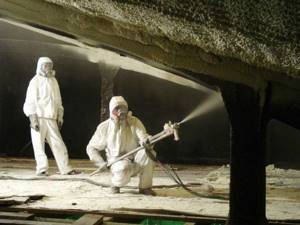
In some cases, water is used to foam polyurethane. This type of polyurethane foam is not recommended for use on galvanized surfaces. This will subsequently affect the service life of the metal. In addition, for galvanized metal, the use of closed-cell polyurethane foam is indicated. It has the required strength. The advantage of this solution is that there is no need for additional fastenings. The process of applying polyurethane foam can be seen in the video below.
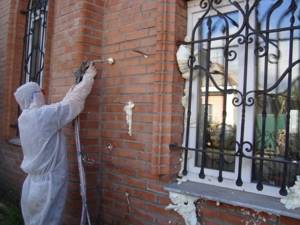
The method of pouring insulation is a rather interesting solution for insulating structures with polyurethane foam. To put it simply, pouring insulation is filling the space between two vertical or horizontal planes. In this case, the mixing of the polyurethane foam components does not take place in the sprayer itself, but in advance. In this case, ready-made polyurethane foam is supplied through the device. The pressure with which the insulation is poured is slightly lower than in the case of spraying. This method of insulation is also used for brick walls. In this case, well masonry is carried out, small holes are drilled or left in the wall itself, through which polyurethane foam is poured.
Insulation of walls with polyurethane foam slabs
In addition to the spraying method, solid polyurethane foam is produced in the form of slabs, which are used for insulation and insulation of walls and facades of houses, and sometimes for insulation of floors. The slabs are manufactured in various densities and thicknesses. They are attached to a pre-leveled, dry, dust-free base using cement-based adhesives, followed by plastering. The quality of their fit depends on the evenness of the wall. After gluing, the slabs are fixed with special dowels with wide heads.
The slabs can be tightly fitted to each other: they will not change their shape and volume under the influence of temperature and moisture. Inconsistencies and cracks that arise during the installation process are eliminated using polyurethane foam, which is sprayed from a spray can. Since these materials have an identical composition, a monolithic surface is formed that hermetically seals the wall. This coating will last for decades.
Polyurethane foam - features
Polyurethane foam is a lightweight, cloud-like insulation material with some technical characteristics superior to ecowool, mineral wool, and steak sawdust. Unlike the analogues listed briefly, it has the lowest thermal conductivity - about 0.019 W/M*Kelvin. This feature gives it the ability to compete with environmentally friendly building materials made from wood and cellulose without any chemicals.
Another positive side of polyurethane foam is its low water absorption. Thanks to him, he practically does not absorb water, much less retain it inside. When treating brick, wood or concrete with polyurethane foam, a barely noticeable film is formed on the surface, like the one that forms on asphalt in the first days of a snowy winter. It repels liquid particles penetrating into the porous structure, leaving room for them outside.
Polyurethane foam does not ignite and burns, as evidenced by its compliance with the All-Russian state standard “GOST 12.1.044-2018” on flammable substances. When sprayed, it creates a powerful acoustic shield. Absorbs sound waves up to 30 decibels. It has waterproofing properties, thanks to which it is used in almost all industrial sectors. Where did he come from, so “beautiful”?
Some useful tips
If you decide to insulate a frame, wooden or brick house with polyurethane foam, then you need to take into account several important points that professionals pay attention to:
- insulation of floors and walls using polyurethane foam spraying technology should be carried out only from the outside;
- it is necessary to provide maximum protection of the polyurethane foam from moisture, ultraviolet radiation, and air from the outside, and this protection must be maintained throughout the entire operational period;
- if the walls of a frame house are insulated with polyurethane foam - filling voids that arise during its operation due to wear and tear of the insulation - then the tightness of the internal premises should be ensured, that is, the material finishing the walls of the premises should not allow air to pass through;
- When choosing a contractor, you need to focus not only on advertising, but also on the condition of the finished objects that were built with his participation, and objects with the longest service life.
Reviews and practice of application most often provide the most objective assessment of insulation. Usually, users are primarily interested in the shortcomings of materials in order to find out what awaits in the future and whether money will be wasted. Each material has its own characteristics, which can also be considered disadvantages; polyurethane foam is no exception.
Which insulation to prefer
Choosing insulation often becomes an overwhelming task for the consumer. There are too many technical nuances that are not obvious at first glance. The heat insulator is specified in the project, but it is difficult to solve the problem on your own.
Every insulation product has disadvantages, which the developer is not aware of or has a false idea due to advertising. For example, the durability of materials, about which very contradictory data are given in different sources, cannot be considered an advantage for many materials.
The eternal question of what to give preference to is best solved by acquiring ready-made reviews, operating experience... Or acting according to the approved documentation...
What is polyurethane foam?
Polyurethane foam is synthesized directly on the construction site by mixing complex components using special equipment. Therefore, insulation services with this material are provided only by organizations with special equipment. Independent use of polyurethane foam is impossible.
As a result of the constant slight expansion of the foamed substance and its hardening, a material with a porous structure is formed, 90 - 95% of the volume consisting of voids in the cells. But the characteristics are unique - the highest degree of thermal insulation among artificial materials. At the same time, the price is moderate. Specific costs for very large volumes are low, i.e. over large areas the material also becomes advantageous.
Individual disadvantage
But the creation of polyurethane foam occurs every time without standards, “like an uncle twisting a pen.” This also entails its big drawback - the characteristics will completely depend on the desire of the creator, his conscientiousness, the quality of the equipment, the quality of the components...
The most important parameter is achieving the design specific gravity - kg/m3. Strength characteristics, thermal insulation coefficient, vapor permeability will depend on this... But the creators want to fill the volume and spend as few components as possible….
Therefore, one of the most important indicators of this material is simply consumer reviews of a particular organization involved in spraying. To avoid negative consequences, independent technical control at the construction site is also important.
Afraid of the sun
The effect of ultraviolet radiation on most synthesized plastics is negative. Irradiation destroys chemical bonds and the structure of the material. Users comment on the shortcoming - “the material turns yellow and shrinks.”
When coating external surfaces, it is not recommended to keep polyurethane foam in the sun without protection. In any case, manufacturers may not focus on this. But reviews of polyurethane foam speak precisely to the need to protect it from radiation.
Can be used under protective putty or paint. True, external use is questionable due to another disadvantage of the material...
No flat surface
A typical area of application for polyurethane foam is in cavities covered by hinged panels. Or in places that do not need aesthetic evaluation. Why panels that are hung on the sheathing?
Because it is not profitable and difficult to apply a plaster and paint layer on top of the material. A too uneven surface is created. Spraying is done individually, as the master can. And the thickness of the layer is determined by the average result, while in some places it can be +- 2 cm.
Vapor barrier - advantage or disadvantage?
Reviews about polyurethane foam say one thing - it is better not to use it on vapor-transparent materials from the outside. The insulation will block the escape of moisture from wood, from aerated concrete, from expanded clay concrete... It is better to use the material strictly in accordance with the design, where the structures are specially designed, for example, vapor barrier membranes are provided.
Doing it on your own can literally lead to disastrous results for the wall (structure) - water will flow from it. Thus, the property of the material to poorly allow water vapor to pass through itself will turn into a major disadvantage if used ineptly...
Penoizol and polyurethane foam
These two types of liquid insulation are included in the group of foam plastics. This is the name given to all types of foamed polymers used in construction for insulation and thermal insulation.
However, in the understanding of most consumers, polystyrene foam is a sheet heat-insulating material. In fact, only polystyrene foam is such, which is produced in a factory by exposing the polymer composition to high temperature. As a result, foaming and hardening of the insulation occurs.
Penoizol and polyurethane foam, unlike conventional polystyrene foam, are most often used in liquid form. This allows you to insulate complex structures and internal cavities in walls and partitions.
Penoizol is a liquid urea-formaldehyde foam that requires only a low temperature (from +15C) to harden. An important advantage of this insulation is good vapor permeability. This allows you to use penoizol for pouring into the walls of buildings.
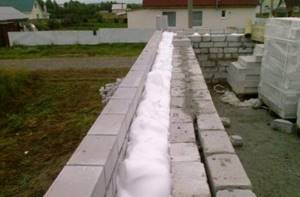
Expanded polystyrene sheet foam is not suitable for this. It practically does not allow water vapor to pass through, which leads to the accumulation of moisture inside the walls, the loss of their heat-insulating qualities, and the appearance of mold and dampness.
Another advantage of penoizol is fire safety. This material does not burn, but only melts under high temperature and does not emit toxic gases.
Penoizol fills well the unevenness and voids inside the masonry, but does not expand in volume. Sellers of this thermal insulation consider this fact to be an advantage.
However, reviews from developers who insulated attic floors with foam insulation contain complaints that through cracks form in it. This leads to a decrease in thermal insulation properties. This phenomenon occurs due to shrinkage of this insulation over time. This drawback is partially eliminated in ECO brand elastic foam insulation, which is made on the basis of non-toxic resins.

Unlike polyurethane foam, penoizol cannot be applied to walls by spraying, which is a technological disadvantage. Pouring is the only way to use this insulation. Some manufacturers produce sheet penoizol, which can be used to cover the outer surfaces of walls.
The open porous structure of penoizol ensures good removal of water vapor from a heated room, but requires reliable protection from moisture. Therefore, when facing walls, its surface must be protected with a layer of water-repellent cement-sand plaster.
Comparative table of the main characteristics of penoizol and polyurethane foam
| Parameter | Penoizol | Polyurethane foam |
| Density, kg/m³ | From 10 to 35 | From 12 to 80 |
| Thermal conductivity coefficient W/m*K | 0,035 – 0,047 | 0,019-0,025 |
| Vapor permeability mg/m*h*Pa | 0,21 – 0,24 | 0,5 |
| Operating temperature range | From - 50 to + 120 C | From -100 to +150 C |
| Flammability group | G2 (hard to burn) | G2-G3 |
| Water absorption,% | 10,5 – 20 | 1,2-2,1 |
| Price, thousand rubles/m³ | 1,3-1,6 | 4-12 |
Scope of application
Sprayed thermal insulation today is the most promising method, which is predicted to have a great future. Previously, it was not widely used due to the high cost of raw materials and equipment.
With the advent of sprayed insulation in cylinders, the situation has changed. Now you don’t need to invest in expensive equipment or look for specialists who can do this work efficiently.
In this video you will learn how to insulate a balcony:
Sprayed insulation is used in the construction of the following objects:
- industrial and residential premises (facades, basements, attic floors);
- roofing structures;
- foundation;
- vegetable storage;
- industrial refrigerated warehouses;
- garages, hangars;
- log floors;
- heat pipes and pipelines.
Areas of application, spraying and the best manufacturers of polyurethane foam thermal insulation
What are they insulating?
Insulation of PPU pipes
Innovative polyurethane foam insulation, which proudly demonstrates good technical characteristics, is used for thermal insulation of the following objects:
- Industrial buildings (hangars, warehouses, service stations, prefabricated buildings, car washes, cowsheds, etc.);
- Private houses and commercial buildings;
- Refrigeration equipment;
- Technological containers;
- Pipeline communications.
The substance is universal because it insulates:
- roofs and roofs;
- ceilings and floors;
- walls, partitions and facades;
- basements and plinths;
- building foundations.
Sputtering technology
The work is carried out as follows:
- the first substance is poured into the container and mixed well using a mixer;
- the second component is prepared in another container (if there is sediment, it is heated to +70°, stirred and filtered);
- in the third container the prepared ingredients are mixed;
- the substance is poured into special equipment from which it is sprayed onto the surface.
It is advisable that the work be performed by an experienced craftsman. As the great Dunno said, “every business needs to be learned.” This expression is also acceptable here. At first glance, there is nothing complicated about the work. But only a specialist will be able to make a surface that is even and uniform in thickness.
Famous manufacturers
Today, spray-on insulation materials from:
- “Polinora” (there is more detail about it in this article);
- "Ecotermix";
- Foam Kit;
- Heatloc Soy.
Of course, there are other well-known manufacturers that produce PU foam insulation, but products from these “KITS” are in greatest demand (or better “promoted” by marketers). A “fur coat” donated to the building will certainly not allow Winter to steal precious warmth from your home!
Advantages and disadvantages
There are no ideal materials among insulation materials; all have not only advantages, but also disadvantages. Polyurethane foam material has a number of advantages over other heat insulators:
- Low thermal conductivity . Polyurethane foam is a good barrier to heat loss. It is perfect for internal thermal insulation, as it is enough to apply a small layer of foam.
- Waterproofing properties . The composition of the material allows it to be used as waterproofing. It perfectly protects against corrosion.
- No seams . The method of applying insulation (spraying) allows you to obtain a seamless layer. There are no joints formed in the areas where the foam adheres, through which the cold passes.
- High adhesion . The insulation adheres well to any building materials, the surface of which has been previously cleaned of debris, dust and degreased.
- Chemical neutrality . Polyurethane foam does not react chemically with other building materials and installation solutions. The insulation layer is resistant to aggressive chemicals (except petroleum products).
- High strength . After the foam polymerizes, it becomes so strong that it can withstand strong mechanical loads. It can even be used to insulate foundations that are buried in the soil. During operation, polyurethane also shows high strength.
- Fire safety . Due to the fact that the composition includes a fire retardant, this insulation has been awarded a fire safety certificate. The material not only ignites poorly, but also contributes to the self-extinguishing of fire.
- Long service life . Polyurethane does not absorb water, thanks to which it is not destroyed by adverse weather conditions and temperature changes (with the exception of ultraviolet rays). If all conditions were met during installation, it will retain its high technical characteristics for at least 50 years.
- Easy to install . Any craftsman can handle spraying insulation; there is no need to nail down brackets or install sheathing.
Disadvantages of sprayed polyurethane insulation:
- The material is characterized by low ultraviolet resistance. When irradiated, the structure of polyurethane foam disintegrates, so it is always protected from the outside with decorative materials. Cement plaster, panels, and siding are used.
- The work requires the use of special equipment. A compressor is required for spraying, and a construction mixer is required for mixing the components. It is not necessary to buy all this equipment; it can be rented.
- It is necessary to use protective equipment. When spraying polyurethane, a large amount of carbon dioxide is released, which is harmful to humans. Work should be carried out in a respirator and overalls (or other protective clothing).
- High price. Spray insulation is more expensive than other insulation materials - mineral wool or polystyrene foam.
Rating of expensive products up to 1000 rubles
Irfix (4631141152769), 890 ml
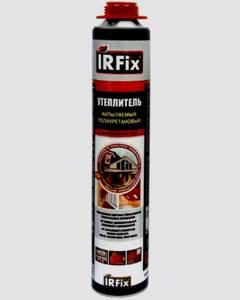
The Russian manufacturer has launched the production of high-quality and reliable sprayed polyurethane insulation. Reviews about the product are only positive. You can purchase it either in an online store, by placing an order online, or by visiting any specialized retail outlet. Sold in cylinders. The kit includes a special gun for applying the composition to the surface. The product is intended for both internal and external work. The minimum temperature of use is 5 degrees Celsius.
Drying speed is average; for complete curing you need to wait a day. Belongs to the professional class. It has excellent thermal insulation characteristics. Resistance to significant temperature changes has been revealed. It is advisable to use in summer. The composition contains chemical components, so it must be applied carefully, using protective equipment. It is afraid of severe frosts, losing its original properties. The fire resistance indicator is high. During use, the foam expands slightly.
The product is intended for thermal insulation of pipelines, buildings, any building structures and structures, regardless of the complexity of the form. It fits perfectly and lasts well for a long time on wood, concrete, brick, stone. It is advisable not to use for application on polyethylene, Teflon, polypropylene. Over the years it does not deform and does not change its original qualities. Protects paint, putty, plaster from ultraviolet radiation.
The average cost is 609 rubles.
sprayed polyurethane insulation Irfix (4631141152769), 890 ml
Advantages:
- ease of use;
- no odor;
- not afraid of ultraviolet rays;
- practicality;
- efficiency;
- reliability;
- versatility;
- value for money.
Flaws:
- not identified.
Tris
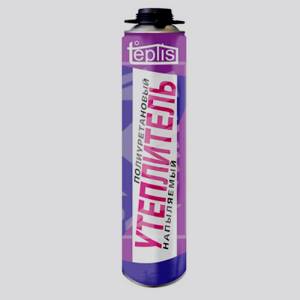
The products are manufactured by a domestic manufacturer. It looks like a gas-filled polymer. The structure is foamy-cellular. Can be applied to interior and exterior surfaces. Ideally attached to plastic, wood, stone, brick, glass, metal, concrete and other building materials. The frozen mixture is completely odorless, exhibits unique resistance to pathogens and fungi, and prevents mold from appearing. The top can be painted or finished.
The density is insignificant, the thermal conductivity is impressive. The cells are filled with air, which significantly increases the insulating capacity of the material. Soundproofing and heat-saving characteristics at a high level. A completely dried ball has a thermal resistance R (1.85 K/W). The polymer is sold in aerosol cans of 1000 ml. The shelf life reaches one and a half years.
The product is very popular among professional craftsmen. Often purchased for household needs. It is used for thermal insulation of industrial and residential premises. Helps to escape from the cold in severe frosts and heat in sultry summers. Suitable for application to complex geometric structures. Eliminates cold bridges. Absorbs sounds and prevents them from leaking into rooms.
It is advisable to use at an ambient temperature of 18 degrees Celsius. It is applied using a special gun with an adjustable spray head. Promotes uniform application of the layer. After 6 minutes a crust will form. Complete polymerization occurs within one hour. Package weight – 995 grams.
Purchase price – 520 rubles.
sprayed polyurethane insulation Tris
Advantages:
- ease of application;
- versatility;
- excellent adhesion;
- reliability;
- long service life;
- perfect sound insulation;
- not afraid of temperature changes;
- practicality;
- functionality.
Flaws:
- none.
PenoPlex FastFix (850 ml)

One-component polyurethane insulation. Apply by spraying onto prepared substrates. Belongs to the category of universal. Suitable for use in a variety of building structures, outbuildings, residential and industrial premises. It holds firmly on both horizontal, vertical and inclined bases, including those with a negative slope (roofs, slopes, etc.).
Often used on small objects. It can be used both independently and as additional thermal insulation. Ideal for uneven walls and surfaces with irregular geometry, where sheet material cannot be used. The main component is polyurethane. Capacity volume – 850 ml. Density indicator – 16 – 20 kg/cub.m. Withstands temperatures from 45 degrees below zero to 90 degrees above zero. Complete curing occurs within 24 hours. A dense crust appears after 15 - 20 minutes. Fire resistance class – B2. The color of the product is bright orange.
Retailers offer products at a price of 500 rubles. If you order online, you can get it a little cheaper.
sprayed polyurethane insulation PenoPlex FastFix (850 ml)
Advantages:
- practicality;
- safety;
- ease of use;
- hardens quickly;
- retains its original characteristics for a long time;
- positive reviews;
- value for money;
- excellent adhesion to any building materials;
- versatility;
- reliability.
Flaws:
- absent.
Features of installation of thermal insulation
Spraying of insulation is carried out in dry and warm weather. If it rains while working, the process must be paused and wait for the already applied layer to dry. The insulation is applied by spraying (layer no more than 1.5 cm). After applying the first layer, wait until it hardens.
Insulation begins from hard-to-reach places, each layer is applied after the previous one has dried.
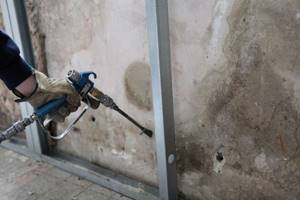
To ensure high thermal insulation, at least three layers must be applied. Any material is placed on the surface to be treated for better adhesion.
The work must be completed in one day. If the surface area to be treated is large and you have to stop work, before starting the next stage it is necessary to carefully prepare the surface again.
Spraying is carried out in special cotton overalls, rubber boots, safety glasses, rubber gloves, and a respirator.
Installation difficulties
People who have dealt with PU foam shotcrete do not question the merits of this material as an insulation material. This is a practical, durable and safe material that fully justifies its cost. But spraying polyurethane foam has a number of unpleasant features.

First of all, the entire process, from preparing the mixture to its supply and application, has an extremely complex technology. It is impossible to reproduce the high quality obtained using expensive professional equipment in homemade practice, otherwise the whole point of buying expensive raw materials is lost.
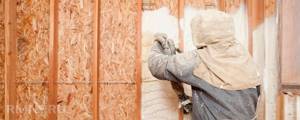
Another difficulty is the few but strict requirements for the condition of the surface being treated. It should be dry, free of dirt and oil stains. Although polyurethane foam is very tenacious to almost all materials, the presence of foreign impurities can reduce adhesion to zero.
What is polyurethane foam?
Few people know, but polyurethane foam (PPU), which is in demand today, was manufactured back in the last century. It was first used as thermal insulation in 1957. Since then, it has not only not lost its relevance, but has also begun to be used in other areas far from construction. It is polyurethane foam that is one of the fillers in upholstered furniture, children's toys, etc. What is polyurethane foam?
At its core, polyurethane foam is one of the types of plastics. The uniqueness of the material lies in the fact that the main percentage of the substance is gas bubbles. According to studies that have been repeatedly carried out with the finished product, modified plastic in the finished product is only 10-15%. The rest of the space is occupied by gas bubbles. As a result, the material acquires special thermal insulation and performance characteristics.
. Namely:
- A 3 cm layer of polyurethane foam is identical in thermal conductivity to 7 cm, 16 cm mineral wool, 38 cm foam block and 1 m 70 cm brick wall.
- The material can be prepared directly at the construction site or purchased ready-made mixture in cylinders.
- Tests have shown that polyurethane foam retains its performance characteristics over a range of - 150° to + 220°.
- Has high adhesion to any surface
. Using polyurethane foam you can even insulate a metal structure. - After drying, the surface can be plastered or used as a base for laying ceramic tiles.
You need to know that there are several methods of insulation using polyurethane foam. You can purchase sheet material, prepare a two-component composition yourself, or use a ready-made mixture sold in containers resembling polyurethane foam.
Cost of work and materials
The cost of insulating walls with sprayed polyurethane foam consists of the cost of purchasing the material, which is offered on the market in cans, and carrying out the work.
When determining the volume of work performed, they proceed from cubic meters of insulated surface or calculate the volume in square meters, depending on the thickness of the layer and the type of polyurethane foam used. Depending on the calculation method, the price for such insulation can be from 12 thousand rubles. per cubic meter or from 750 rubles. per square meter. If the owner of a building decides to insulate structures with sprayed polyurethane foam with his own hands, he, of course, will need to purchase the material itself in sufficient quantities, and in addition a set of equipment. Before starting work, you will have to understand the specifics of using the equipment and learn all the intricacies of PU foam insulation technology.
Description and characteristics
Polinor is produced in a liquid state and applied to the surface by spraying. This popularity of the material is not caused by chance, because it is characterized by the following advantages:
- Fast drying. The surface becomes hard after 1 hour.
- Unaffected by rodents and insects.
- Does not form cold bridges.
- Does not harm the human body.
- There is no need to buy expensive equipment for application.
- The material is characterized by high efficiency.
- Has a long service life.
- The structure of the material is closed cells that do not allow water or steam to pass through.
- The material is self-extinguishing if there is no direct influence of fire.
Polinor is not without its disadvantages, which include:
- A surface made of Polinor is resistant to direct influence of UV rays and constant contact with water, and the process of applying the material must take place at a temperature of 15-25 degrees.
- When working with insulation, you must adhere to safety rules using a mask and respirator.
Compared to existing analogues of liquid thermal insulation for walls, Polinor insulation is significantly different. First of all, the changes concern the structure, or more precisely, the percentage of open and closed cells in the solid mass. This criterion is very important, as it affects the level of thermal conductivity, moisture absorption and water permeability. Using Polinor, you can get about 70% of the cells, while when using similar sprayed products, the number of closed-type cells will be only 30-40%. However, it cannot be used as a seal for interior doors.
On the video, liquid insulation in cylinders Polinor:
The material in question has the lowest thermal conductivity among all the insulation materials that are available on the domestic market today. For example, mineral wool has a thermal conductivity coefficient of 0.045, expanded polystyrene – 0.033, and Polinor – 0.023 W/m2* °C. Thanks to these properties of the heat insulator, it is possible to reduce its consumption. One cylinder will be enough to treat 1.2-2.0 m2.
Sprayed thermal insulator Polinor can be applied at temperatures from -25 to +125 °C. If it is exposed to a temperature of 450 degrees, then its length will be deformed by 85%, and damage by weight will be 50%. The duration of its independent combustion will be 5 minutes.
Polinor is an environmentally friendly insulation material, thanks to which it can be used when arranging a residential building. The material has high adhesive properties to various surfaces, resistance to moisture, chemicals and aggressive environments.
For those who want to learn more about what the characteristics of Izover insulation are, you should follow the link and read this information.
What density is best to use for roof insulation and how to choose it correctly is described in great detail in this article.
But which side to put the insulation with foil on and how easy it is to do this is described in great detail in this article: https://resforbuild.ru/paneli/utepliteli/rulonnyj-s-folgoj.html
But what is the price of insulation for walls inside the house and how the price affects the dimensions is described in great detail in this article.
Advantages of using thermal insulation with spraying
Compared to sheet analogues, Polynor sprayed insulation saves time and money, and is easy to store, transport and use. This material also has a number of other advantages:
- minimum curing time (up to one hour);
- resistance to destruction by insects and rodents;
- complete surface coverage without the formation of cold bridges;
- no harmful effects on humans and the environment;
- spraying without complex and expensive devices;
- base vapor barrier;
- long service life.
The insulation is non-flammable and quickly extinguishes when overheated, which guarantees a high level of fire safety.
Application
It is allowed to use Polinor insulation both inside and outside the house. At the same time, make sure that it is not directly affected by sunlight and moisture. The installation process is very simple and quick, and even an inexperienced person can cope with the task. All that is required is to install the container on the spray foam gun.
But before this, it is important to properly prepare the surface. It must be cleaned of dust, dirt and moistened with water. The process of applying foam is performed with smooth movements, without jerking. Thanks to this, you can obtain a uniform layer of insulation. Polymerization occurs through reaction with moisture. If you additionally moisten the surface, the composition will be more voluminous. Rubber door seals can provide additional insulation.
Video showing the use of sprayed polyurethane insulation polynor:
In addition, the material becomes lush even at a temperature of 20 degrees. But at a temperature of 15 degrees, the composition becomes dense. The material can be applied both to the frame and to the wall. The choice of a particular method depends on the subsequent cladding.
The following options are provided:
- applying paint;
- applying a layer of plaster;
- use of drywall, OSB, lining, siding.
Polynor insulation is sprayed on in several layers. It can be used not only for thermal insulation of walls, but also floors and roofs. It is often used when insulating various metal tanks and communications.
The sprayed composition is able to pass through all cracks and hard-to-reach places, forming a monolithic seamless layer. It will not allow heat, steam and moisture to pass through. The material should only be applied with gloves and safety glasses, as it has a strong and pungent odor. It is very difficult to be in an unventilated room, but after installation the smell disappears very quickly.
